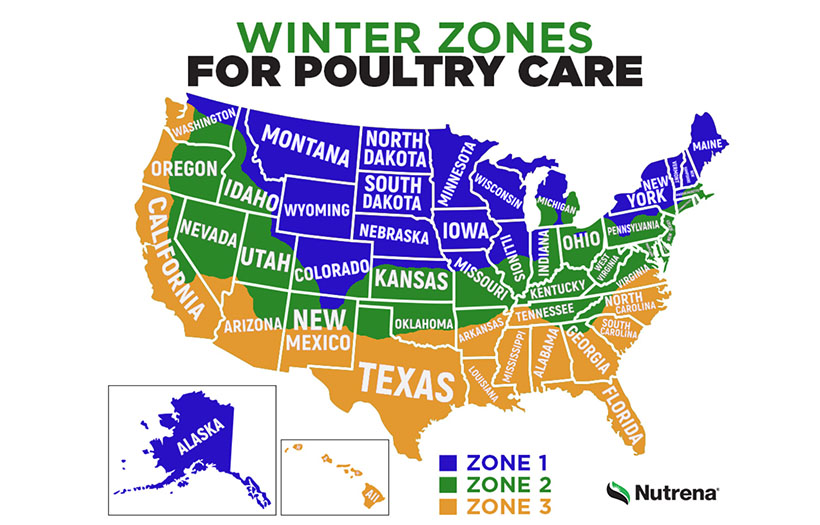Poultry Winter Care for Varying Climates

We all know the importance of preparedness for winter, especially for our feather friends, but sometimes that means different things to different regions of our country.
Winter can sure mean something else to a Minnesotan in comparison to a Texan, so read on (and reference our handy map!) to find the best winter readiness tips for your portion of the US.
Zone 1 – Coldest Region:
- Heated waterers. Dehydration can happen (yes, even in winter) if your chickens don’t have an adequate water source.
- Eliminate coop drafts. Plug cracks in walls or around windows with caulking or bits of fiberglass insulation that can be pushed into gaps with a screwdriver. Bits of cloth work in a pinch.
- Avoid metal perches. (Think of your tongue to a metal pole on a cold day, same discomfort can apply to your chickens).
- Keep feeders filled and treat the hens to some extra grain. Corn and scratch are low in protein but high in cold fighting energy. Chickens also eat more when it’s cold.
- Put a coating of Vaseline on combs and wattles. These are the body parts most likely to be frostbitten. (Thinking ahead, consider buying breeds that have tiny pea combs, which are much less likely to freeze than breeds that sport large single combs.)
- Warm the birds slightly. There is an enormous difference between zero and 25 below zero. It’s not necessary to make the coop warm but it is important to take the edge off extreme cold. Warming the interior of the coop to zero on very cold nights will help the birds come through the chill in good shape.
- Coop ventilation. Obviously you want to prevent drafts in your coop, but a small vent in the top corner can help to keep air fresh in an otherwise tight, sealed up space.
Zone 2 – Middle Region:
- Water source. Again, making sure your chickens have an adequate water supply that isn’t freezing is key to overall health and egg production.
- Safe outdoor option. In this middle region of the country, you might consider outdoor options for your chickens during the day. A great consideration would also be an automated pop hole door set to a timer that allows your chickens that outdoor time during the day, while still keeping them safe and warm at night.
- Back-up plan for power outages. Consider the possibility of loss of power due to ice storms or other weather conditions. Take extra precaution during these times to make sure your chickens still have access to water.
Zone 3 – Warmer Region:
- Keep coop clean and dry. This is always an important consideration, but wintertime in the warmer regions might mean more moisture build-up, thus requiring a little extra care in the way of coop cleanliness.
- Wind protection. Although the temperatures might not warrant extreme measures of protection, it is worth noting that wind and cooler temps can leave your ladies feeling a bit cold. So keeping an eye to the forecast and planning accordingly can help in coop comfort.
- Chick preparation. The southern regions of the US will likely be receiving chicks much earlier than in the north, so planning for their arrival will be part of your winter checklist.
So remember, with a little foresight and planning, winter is sure to be a lot more comfortable this year for both you and your chickens. No matter where you’re located!
